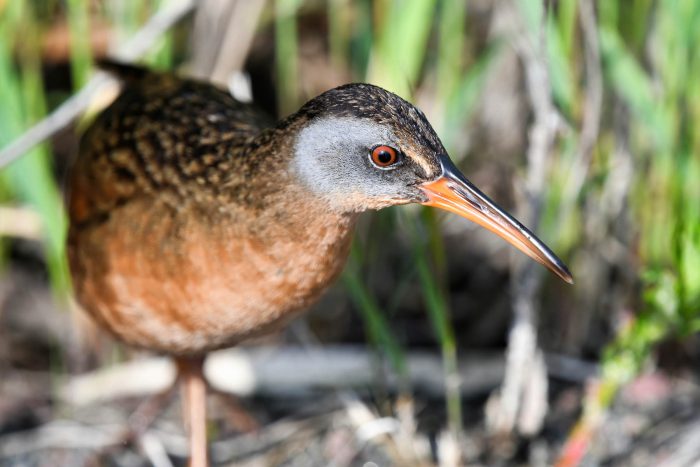Virginia rail
Rallus limicola
The Virginia rail is a small bird with a pig-like grunting call that can be found in the fresh and brackish marshes of the Chesapeake region year-round.
This section shows one large critter image at a time. Use the thumbnails that follow to select a specific image to display here.

This gallery contains a grid of small thumbnails. Selecting a thumbnail will change the main image in the preceding section.
Appearance
The Virginia rail has a small, chicken-like body with a short, upward-turned tail. It has grey cheeks, a brownish-red throat and breast, black and white banded sides and brownish-red legs. Its bill is long, slightly curved and reddish in color. Virginia rails grow to about 10 inches tall with a wingspan of about 15 inches.
Feeding
Virginia rails eat mostly invertebrates, such as insects, insect larvae and crustaceans, but they will also eat small fish and frogs. During winter months, they will sometimes eat aquatic vegetation. The rail wades in shallow water near emergent vegetation which are plants along the water's edge, and will use its bill to probe the mud for invertebrates.
Predators
Raptors, snakes, rodents, cats and predatory fish all prey upon the Virginia rail. To escape predators, the rail can use its wings to swim underwater and use its body to quickly navigate through dense stands of emergent vegetation.
Flight
These birds rarely fly, except during migration. Their flight is weak and not graceful, often lasting only a few yards at a time.
Voice
The Virginia rail's call is a series of kuk-kuk-kuk sounds, sometimes described as grunt-like.
Reproduction and life cycle
Courtship begins around May, when birds form monogamous pairs at breeding grounds. Pairs participate in preening, courtship and territory defense before mating. Both males and females build a nest, as well as a few "dummy" nests throughout the marsh. Nests often have a canopy made of bent-over cattails or bulrushes. Females will lay eight or nine eggs, and both parents will incubate the eggs for 19 days before offspring hatch. Chicks are black and downy, and they develop rapidy, swimming only 11 hours after hatching. After about 25 days, offspring develop wing feathers suited for flight. Pairs will often raise a second brood during a mating season. By November, most birds will have departed from the breeding grounds.
Did you know?
- Feathers on the Virginia rail's forehead are adapted to withstand pushing through dense marsh vegetation.
- The Virginia rail, along with other rail species, has the highest leg muscle to flight muscle ratio of all birds. Their muscular legs allow them to easily slip through dense vegetation.
Sources and additional information
- Animal Diversity Web: Rallus limicola – University of Michigan Museum of Zoology
- All About Birds: Virginia Rail – The Cornell Lab of Ornithology
- Virginia Rail – Audubon Field Guide to North American Birds
